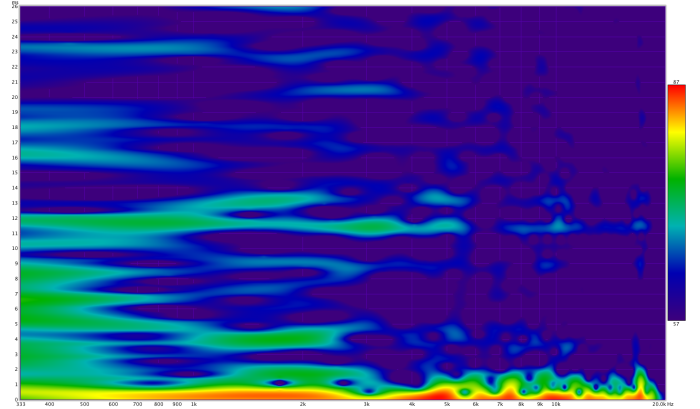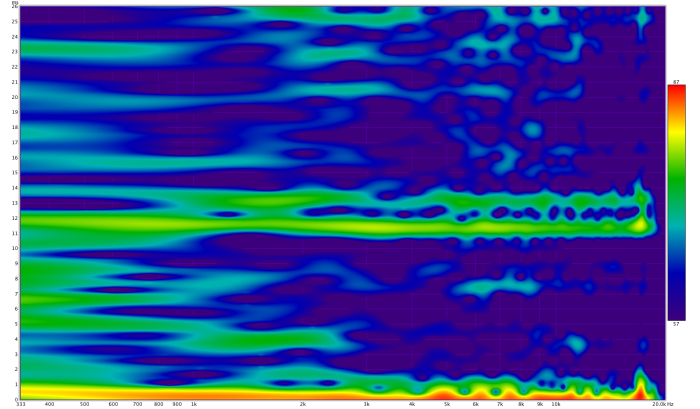Probably a binaural effect? The head works as a barrier to some extend, so stereo might indeed be capable of wave field reconstruction for a very specific type of signal.
What do you mean by binaural effect ?
I faintly remember his reasoning was that stereo triangle generate very low IACC at narrow freq band somewhere in 2kHz region which results in spaciousness with special signals like applouse.
Time to read carefully what Griesinger has to say about engaging sound and what kills it.
He appears to promote multichannel. And often speaks for decorrelated reverberation. Almost anti-stereo, I would say.
But your barrier experience shows, that "near field" ist still full of crosstalk and reflections dominated by the listening room. Could it be that you need to change to binaural listening completely? Stereo simply isn't up to your standards.Have you looked at the ETC I had posted? I'm listening in the near field...
Rudolf
I would also look at the first 1ms range. If it can drop 15db or more in the first 0.5ms, then it's quite good.For what it's worth, left speaker at listening position, with absorption of contralateral reflection:

With no absorption:

Settings are the same as in your graph.
But your barrier experience shows, that "near field" ist still full of crosstalk and reflections dominated by the listening room. Could it be that you need to change to binaural listening completely? Stereo simply isn't up to your standards.
Rudolf
I don't think the barrier has much to do with room reflections. I think it removes spurious time delay cues caused by crosstalk of the direct signal. My current barrier is just 50x100cm in size, i.e. the speaker "sees" a barrier of 50x50cm which blocks frequencies from 700Hz and higher.
Stereo is what it is. I'm simply looking at all of this in depth to get a feeling when good is good enough.
In the end stereo is a single seat and head-in-a-vice solution and anything that could eliminate this limitation is either headphone-based or employs some sort of beamforming with headtracking.
Last edited:
What do you mean by binaural effect ?
Anything that is based on a crosstalk cancellation/wave field reconstruction technique.
This seems to be a relatively common complaint around the web, and I don't get it.If I remove reflections (which includes box diffraction effects) then the sound stage shrinks down to the size of a puppet theater, confined to the area between the speakers. There's also no sense of real depth.
I mean, I do "get" why an added sense of spaciousness that has little to do with the source material can be pleasing, but if we're going with accuracy, isn't imaging restricted to between the speakers with minimal depth what "accuracy" IS for the vast majority of music available?
Last edited:
imaging restricted to between the speakers with minimal depth
If this would be all there is, sounds very boring.
Why limit yourself.
perhaps you guys should be looking at how 3d TV without glasses works. Of course, with TV you are only responding to the "direct" light. Maybe a couple of Audio Spotlights that set up left and right ear "hot spots". It would stll be head in a vice, but perhaps with a number of "vices" at different positions. This could probably be acomplished with nonlinear acoustics. But as long as its two speaker stereo, it's not going to make much difference what you do as it's all been done before.
I mean, I do "get" why an added sense of spaciousness that has little to do with the source material can be pleasing, but if we're going with accuracy, isn't imaging restricted to between the speakers with minimal depth what "accuracy" IS for the vast majority of music available?
unfortunately..
try Chesky's Soldier's Tale for example, a classic of what could be achieved when done right. Even my wife was impressed.
if we're going with accuracy, isn't imaging restricted to between the speakers with minimal depth what "accuracy" IS for the vast majority of music available?
Yes.
Have you looked at the ETC I had posted? I'm listening in the near field...
I'm thinking of near field close enough that room effects don't matter. Get close enough to speaker and you can hear lots of engaging, spacious sound and good imaging as well. So the info is in the recording - it's just getting wrecked by the room. QED
It seems to me that in a small room stereo speakers need help - either through room mods or, (more likely), through use of helper channels so that D/R ratio comfortably supports both envelopment and imaging.
perhaps you guys should be looking at how 3d TV without glasses works. Of course, with TV you are only responding to the "direct" light. Maybe a couple of Audio Spotlights that set up left and right ear "hot spots". It would stll be head in a vice, but perhaps with a number of "vices" at different positions. This could probably be acomplished with nonlinear acoustics. But as long as its two speaker stereo, it's not going to make much difference what you do as it's all been done before.
Click on "Dynasonix" at CML Audio Technology
I'm thinking of near field close enough that room effects don't matter. Get close enough to speaker and you can hear lots of engaging, spacious sound and good imaging as well. So the info is in the recording - it's just getting wrecked by the room. QED
It seems to me that in a small room stereo speakers need help - either through room mods or, (more likely), through use of helper channels so that D/R ratio comfortably supports both envelopment and imaging.
How much reflection suppression is enough? The D/R ratio in my living room exceeds specs for control rooms. I have several full range speakers but even when placed very close (like 1-2') there is no realistic spaciousness. I don't think we're talking about the same sensation.
Yes.
Evolution is laughing at us all, and it really annoys me.. At least I am not an audiophool, just thick.
So HOW is it achieved? Please, please, pretty please. You claimed multiple times it could be achieved but never described how it is achieved.
And how can you be so sure it's not a room effect? Or a binaural effect?
They used optimized sources and electronics and really BIG speakers in a relatively large room
MELAUDIA :: littérature
Click on "Dynasonix" at CML Audio Technology
Ask them about the use of the word "Patented"
http://www.ipo.gov.uk/practice-sec-110.pdf
How much reflection suppression is enough? The D/R ratio in my living room exceeds specs for control rooms. I have several full range speakers but even when placed very close (like 1-2') there is no realistic spaciousness. I don't think we're talking about the same sensation.
How much reflection suppression is enough? I don't know though I've found killing the reflections from behind the speakers is helpful.
I've experimented with putting toed in speakers on the room's longest dimension and killing reflections from behind my head. That actually was pretty decent. It improved with a L+R center channel.
I found the best effect, but sort of primitive, was using the surround channels from my receiver. My theory about that was they were just loud enough to mask the room's own reflections that I could hear enough direct sound for imaging to pop out. That was interesting cuz I could turn up the front channels and suddenly, I'd sort of "be there."
How much reflection suppression is enough? Looking at it objectively my small room has quite a bit - carpet, upholstered furniture, big painting on canvas, no glass, and heavy curtain at front; just after the half way point there are big hallways entering both sides and after that it's not got any absorption at all. So yes, it's possible that surrounds could mask the room's own reflections.
Have you experimented with your room's D/R?
- Home
- Loudspeakers
- Multi-Way
- Linkwitz Orions beaten by Behringer.... what!!?